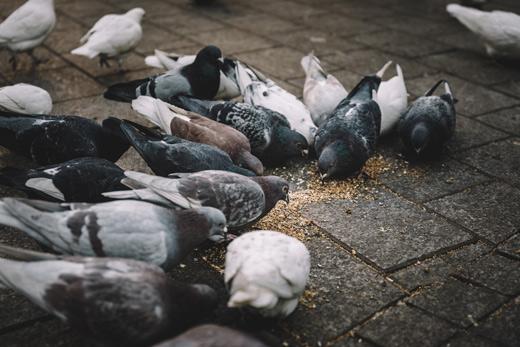Short of exterminating pigeons, there is no fool proof way to get rid of them all, although there are some effective techniques to get rid of most of these birds. First and foremost, pigeon contraception represents an effective method for pigeon control and can substitute for many of the traditional pigeon pest control methods.
For getting deeper insights about all pigeon control methods check Ovo Control’s article here: https://www.ovocontrol.com/how-to-get-rid-of-pigeons
Pigeons have been around for thousands of years and, like rats, are not leaving anytime soon. Also, like rats, pigeons have the natural ability to breed rapidly – two eggs per clutch and up to six clutches per year, depending on the climate. That represents very rapid reproduction and just five mating pairs can produce a population of 400 birds in two years.
In virtually all cases of pigeon infestations, small or large, the birds are causing a problem – they are the source of “pain” for the person or facility that has the uninvited guests. Irrespective of the mess, pigeon feces are highly corrosive and can even etch through steel and concrete.
At 350 grams, pigeons are relatively large birds and consume a total of 60 grams of dry matter and water each day. What goes in eventually comes out the other end as a combination of urine and feces. Consider that a relatively small population of 100 birds will deposit up to 4,800 pounds of “poop” each year. Ultimately, this can represent a serious source of contamination and disease.
Pigeons are considered a pest. Nevertheless, they are still birds and have a different place in our society, than say, rats or cockroaches. Killing pigeons with poison may sound like a good idea to quickly remove them, but, there are other options to get rid of pigeons in a humane way.
Pigeon infestations can range from minor to exceptionally large and uncontrolled. Invariably, the pigeons are causing at best an inconvenience and at worst a health hazard. Unfortunately, the menu of traditional pest control methods is short.
Irrespective of any humane considerations, the casual observer often asks, “why not just kill the birds” for a prompt and effective resolution to a pigeon problem? While culling options provide an immediate and tangible solution to an acute pigeon problem, the effects are mostly fleeting.
Often, the population will simply “backfill” the void created by culling with increased reproduction and even more birds. Only by limiting reproduction with pigeon contraception can you effectively manage the population in a manner to provide long-term control.
Lethal solutions often represent a “harvest” of pigeons as opposed to an actual control program. Both larger and smaller problems can be solved with alternative techniques although all but the simplest infestation require some observation and planning to develop a safe and effective strategy for success.
Pigeon contraception represents the ideal choice at larger facilities where conventional pest control methods are often ineffective.
In addition to culling, traditional pigeon pest control methods typically include physical exclusion, deterrents and repellents. In terms of physical exclusion, nets represent the gold standard. It is easy to understand why this technique represents the most effective method for excluding birds from a specific area.
When professionally installed, a net creates a physical barrier between the area where the birds are located and the area where they are not wanted. Simple! Unfortunately, while simple to understand, netting may also represent the costliest of all options and is clearly not appropriate for all sites and circumstances.
While they can be highly effective, nets may not be the answer to pigeons in larger areas where they quickly become cost prohibitive.
There are also a wide range of deterrents and repellents available, and some may solve problems under the appropriate set of conditions.
Consistent with the philosophy of integrated pest management (“IPM”), trapping, a lethal method, can be combined with other non-lethal methods. For example, a trapping program can be used in parallel with birth control. In this way, the population is managed both by increasing mortality and reducing pigeon reproduction for the best possible outcome.
Although poisons and other methods to increase mortality can be effective in killing birds, the risks truly outweigh the benefits. Seek out other safe, effective, and humane techniques that can help manage your pigeon problem.

